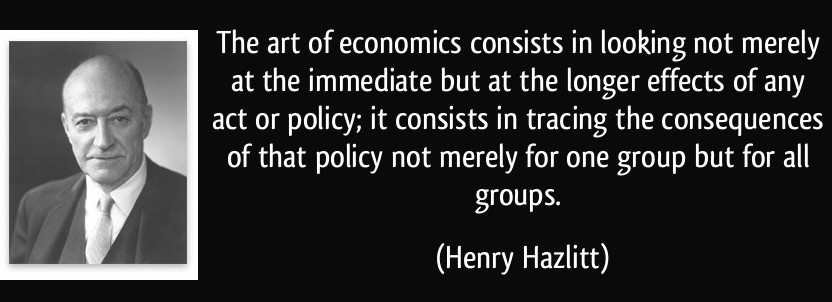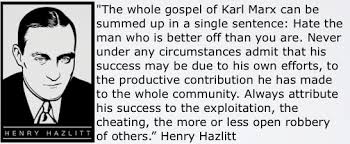|
home | what's new | other sites | contact | about |
||
|
Word Gems exploring self-realization, sacred personhood, and full humanity
Henry Hazlitt Economics In One Lesson The Price System
THE whole argument of this book may be summed up in the statement that in studying the effects of any given economic proposal we must trace not merely the immediate results but the results in the long run, not merely the primary consequences but the secondary consequences, and not merely the effects on some special group but the effects on everyone. It follows that it is foolish and misleading to concentrate our attention merely on some special point -- to examine, for example, merely what happens in one industry without considering what happens in all. But it is precisely from the persistent and lazy habit of thinking only of some particular industry or process in isolation that the major fallacies of economics stem. These fallacies pervade not merely the arguments of the hired spokesmen of special interests, but the arguments even of some economists who pass as profound. It is on the fallacy of isolation, at bottom, that the "production-for-use-and-not-for-profit" school is based, with its attack on the allegedly vicious "price system." The problem of production, say the adherents of this school, is solved. (This resounding error, as we shall see, is also the starting There are so many fallacies in this view that they cannot all be disentangled at once. But the central error, as we have hinted, comes from looking at only one industry, or even at several industries in turn, as if each of them existed in isolation. Each of them in fact exists in relation to all the others, and every important decision made in it is affected by and affects the decisions made in all the others. We can understand this better if we understand the basic problem that business collectively has to solve. To simplify this as much as possible, let us consider the problem that confronts a Robinson Crusoe on his desert island. His wants at first seem endless. He is soaked with rain; he shivers from cold; he suffers from hunger and thirst. He needs everything: drinking water, food, a roof over his head, protection from animals, a fire, a soft place to lie down. It is impossible for him to satisfy all these needs at once; he has not the time, energy or resources. He must attend immediately to the most pressing need. He suffers most, say, from thirst. He hollows out a place in the sand to collect rain water, or builds some crude receptacle. When he has provided for only a small water supply, however, he must turn to finding food before he tries to improve this. He can try to fish; but to do this he A Swiss Family Robinson, perhaps, finds this problem a little easier to solve. It has more mouths to feed, but it also has more hands to work for them. It can practice division and specialization of labor. The father hunts; the mother prepares the food; the children collect firewood. But even the family cannot afford to have one member of it doing endlessly the same thing, regardless of the relative urgency of the common need he supplies and the urgency of other needs When the children have gathered a certain pile of firewood, they cannot be used simply to increase the pile. It is soon time for one of them to be sent, say, for more water. The family too has the constant problem of choosing among alternative applications of labor, and, if it is lucky enough to have acquired guns, fishing tackle, a boat, axes, It would be considered unspeakably silly for the wood-gathering member of the family to complain that they could gather more firewood if his brother helped him all day, instead of getting the fish that were needed for the family dinner. It is recognized clearly in the
Let us now turn to such a society. How is the problem of alternative applications of labor and capital, to meet thousands of different needs and wants of different urgencies, solved in such a society? It is solved precisely through the price system. It is solved through the constantly changing interrelationships of costs of production, prices and profits. Prices are fixed through the relationship of supply and demand, and in turn affect supply and demand. When people want more of an article, they offer more for it. The price goes up. This increases the profits of those who make the article. Because it is now more profitable to make that article than others, the people already in the business expand their production of it, and more people are attracted to the business. This increased supply then reduces the price and reduces the profit margin, until the profit margin on that article once more falls to the general level of profits (relative risks considered) in other industries. Or the demand for that article may fall; or the supply of it may be increased to such a point that its price drops to a level where there is less profit in making it than in making other articles; or perhaps there is an actual loss in making it. In this case the marginal" producers, that is, the producers who are least efficient, or whose costs of production are highest, will be driven out of business altogether. The product will now be made only by the more efficient producers who operate on lower costs. The supply of that commodity will also drop, or will at least cease to expand.
It is true that supply is in part determined by costs of production. What a commodity has cost to produce in the past cannot determine its value. That will depend on the present relationship of supply and demand. But the expectations of business men concerning what a commodity will cost to produce in the future, and what its future price will be, will determine how much of it will be made. This will affect future supply. There is therefore a constant tendency for the price of a commodity and its marginal cast of production to equal each other, but not because that marginal cost of production directly determines the price, Most of us must have noticed the automatic "governor" on a steam engine. It usually consists of two balls or weights which work by centrifugal force. As the speed of the engine increases, these balls fly away from the rod to which they are attached and so automatically narrow or close off a throttle valve which regulates the intake of steam and thus slows down the engine. If the engine goes too slowly, on the other hand, the balls drop, widen the throttle valve, and increase the engine's speed. Thus every departure from the desired speed itself sets in motion the forces that tend to correct that departure.
Costs of production themselves, in fact, might be defined as the things that are given up (the leisure and pleasures, the raw materials with alternative potential uses) in order to create the thing that is made.
For the dying industries absorb labor and capital that should be released for the growing industries. It is only the much vilified price system that solves the enormously complicated problem of deciding precisely how much of tens of thousands of different commodities and services should be produced in relation to each other. These otherwise bewildering equations are solved quasi-automatically by the system of prices, profits and costs. They are solved by this system comparably better than any group of bureaucrats could solve them. For they are solved by a system under which each consumer makes his own demand and casts a fresh vote, or a dozen fresh votes, every day; whereas bureaucrats would try to solve it by having made for the consumers, not what the consumers themselves wanted, but what the bureaucrats decided was good for them. |
||
|
|

